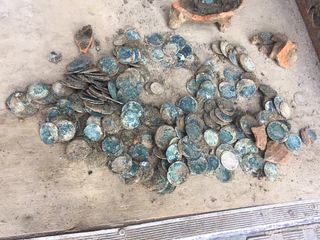Real-Life Pot o' Gold Discovered During Dutch Construction Project

Sometimes you don't need to follow a rainbow, but rather a drain pipe, to find a pot o' gold.
That's what happened for utility workers in the Netherlands, who stumbled across a centuries-old pot of gold earlier this month while laying down new pipes, according to news reports.
The remarkable find includes 500 coins — 12 of them gold and the rest silver — dating to the 15th century, which were nestled inside of a glazed, earthenware cooking pot, according to the NL Times.
Employees of Oasen, a drinking-water company, discovered the treasure on March 1, when they were laying down pipes in Hoef en Haag, a new town in the central province of Utrecht. As soon as they found the coins, the workers called Utrecht's archeological hotline, which sent archaeologists to inspect the area and gather the artifacts. [Top 10 Rare U.S. Coins]
The prize pot also contained textiles, which may have once served as moneybags of sorts to hold the coins, Peter de Boer, an archaeologist at Omgevingsdienst Regio Utrecht (Environment Service Region Utrecht), told RTV Utrecht. The majority of the coins date to the 1470s and 1480s, and some have imagery depicting King Henry VI of England (and the disputed king of France), Pope Paul II, and David of Burgundy, who was bishop of Utrecht.
"Every coin in this treasure is a story in precious metal," de Boer told RTV Utrecht. "Every gentleman gave out his 'business card' by way of a coin, and therefore, there is a lot to discover."
Moreover, the coins may shed light on what happened to the medieval city of Hagestein after it fell in a siege in 1405, de Boer said. "In this sense, we now have a 'pot full of stories,'" De Boer added.
Sign up for the Live Science daily newsletter now
Get the world’s most fascinating discoveries delivered straight to your inbox.
The artistry on the coins may also help researchers learn more about the Burgundian Netherlands, a collection of fiefdoms that included parts of modern-day Belgium, the Netherlands, Luxembourg and northern France that were ruled by the dukes of Burgundy, an ancient lineage of French nobility with deep ties to France's royal family. The Burgundian Netherlands existed from 1384 to 1477, and during that time, some of the coins were still in use, according to the Metropolitan Museum of Art in New York City.
The coins are now being appraised and studied, but will soon be returned to their new owners — Oasen, the project developer and the people who own the land where the coins were found, according to NOS, the Dutch broadcasting foundation.
Original article on Live Science.

Laura is the archaeology and Life's Little Mysteries editor at Live Science. She also reports on general science, including paleontology. Her work has appeared in The New York Times, Scholastic, Popular Science and Spectrum, a site on autism research. She has won multiple awards from the Society of Professional Journalists and the Washington Newspaper Publishers Association for her reporting at a weekly newspaper near Seattle. Laura holds a bachelor's degree in English literature and psychology from Washington University in St. Louis and a master's degree in science writing from NYU.

